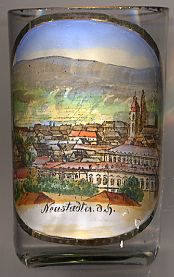

|
| DEUTSCHLAND | GERMANY |
| Bundesland: Rheinland-Pfalz | Rhineland-Palatinate |
| Stadt: Neustadt an der Weinstraße |
Neustadt an der Weinstraße (formerly known as Neustadt an der Haardt) is situated at an elevation of 136 m on the stream Speyerbach, between the Haardt, the eastern foothills of the Palatinate Forest (Pfäzerwald), and the western edge of the Upper Rhine Plain. The municipality has a population of about 53,500 (2009).
The name Neustadt an der Weinstraße means 'New city on the wine route', as it lies on the German wine route (Deutsche Weinstraße).
Neustadt
Soon after the foundation of the settlement in the early 13th century, Neustadt was chartered as a town in 1275. During the Reformation, the Palatinate was ruled by the Palsgrave Ludwig V, a Calvinist, who nevertheless permitted the Lutherans to practice their faith in his countries. Ludwig was suceeded in 1544 by his brother Friedrich II and in 1556 by Friedrich's son Friedrich III. When Friedrich III died, his contries were partitioned between his two sons, the Lutheran Ludwig VI and the Calvinist Johann Casimir (who inherited the districts Kaiserslautern and Neustadt). Johann Casimir founded the university of Neustadt (the Casmimirianum) in 1544. After the death of his brother in 1583, Johann Casimir moved to Heidelberg in order to rule on behalf of his nephew Friedrich IV, who was only 9 years old at that time. This also was the end of the Casimirianum at Neustadt. During the Thirty Years' War (1618–1648) Neustadt was conquered and occupied six times: in 1622 by the Spanish, 1631 by the Swedes, 1635 by the Imperial troops, 1638 by the troops of Weimar, in 1639 and again in 1644 by the French. Luckily, and in contrast to many other towns in the Palatinate, Neustadt did not suffer damages during the Palatinate War of Succession (1689–1697). The medieval fortifications were torn down in the 18th century. After the French Revolution of 1797/1798 all parts of the Palatinate to the west of the Rhine were occupied by France and Neustadt became part of the Départment du Mont-Tonnère (Donnersberg) and Neustadt became the seat of the administration of a canton within the Arrondissement Spire (Speyer). After the collapse of the French regime at the Rhine in 1813/14 and the Congress of Vienna (1815) the largest part of the Palatinate became part of the Kingdom of Bavaria. After World War II Neustadt became part of the Rheinland-Pfalz (1945/46). In 1969, the communities of Geinsheim, Gimmeldingen, Haardt an der Weinstraße, Hambach an der Weinstraße, Königsbach an der Weinstraße, Lachen-Speyerdorf, Mussbach an der Weinstraße and Diedesfeld were incorporated into Neustadt, the community of Duttweiler followed in 1974.

The  Stiftskirche (abbey church) [right]
goes back to a parish church, dedicated to St. Egid (St. Ägidius), of the 13th century.
In the 14th century it became a memorial church for the Wittelsbach dynasty. Palsgrave Rudolf II was buried in front of the main altar in 1353.
His brother and successor, Palsgrave Ruprecht I founded the collegiate monastery in 1356. The Romanesque church was enlarged in Gothic style and was dedicated to Our Lady,
the patron of the Wittelsbach dynasty. Palsgrave Ottheinrich introduced the Protestant faith in the Palatinate and the collegiate monastery was finally closed in 1566.
Beginning in 1700 the church was used again by Catholics, this time simultaneously to the Protestants. In 1705, the Catholics received the choir, whereas the
Protestants, larger in number, received the nave. In 1707/08 a wall was erected between the two parts until today the church is divided into a Catholic and Protestant part.
In 1862 the patronage of Our Lady was transfered to the new, neighbouring Lady church, and the collegiate church again was placed under the patronage of St. Egid.
Stiftskirche (abbey church) [right]
goes back to a parish church, dedicated to St. Egid (St. Ägidius), of the 13th century.
In the 14th century it became a memorial church for the Wittelsbach dynasty. Palsgrave Rudolf II was buried in front of the main altar in 1353.
His brother and successor, Palsgrave Ruprecht I founded the collegiate monastery in 1356. The Romanesque church was enlarged in Gothic style and was dedicated to Our Lady,
the patron of the Wittelsbach dynasty. Palsgrave Ottheinrich introduced the Protestant faith in the Palatinate and the collegiate monastery was finally closed in 1566.
Beginning in 1700 the church was used again by Catholics, this time simultaneously to the Protestants. In 1705, the Catholics received the choir, whereas the
Protestants, larger in number, received the nave. In 1707/08 a wall was erected between the two parts until today the church is divided into a Catholic and Protestant part.
In 1862 the patronage of Our Lady was transfered to the new, neighbouring Lady church, and the collegiate church again was placed under the patronage of St. Egid.
Further places called Neustadt (or similar), of which glasses are in this collection, are:
[https://de.wikipedia.org/wiki/Neustadt_an_der_Weinstraße, https://de.wikipedia.org/wiki/Stiftskirche_(Neustadt_an_der_Weinstraße)]
in Austria:
in the Czech Republic:
in Germany:
in Hungary:
in Poland:
in Romania:
![[scale]](lineal.jpg)